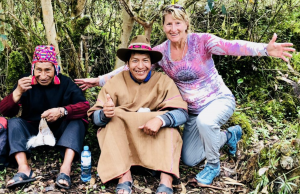Join Women’s Quest for a Peruvian Despacho Ceremony with Paqos from the Q’eros community!
Join us on November 14th at 2pm (MDT) to support a community that has been heavily hit by the pandemic.
We will learn about and partake in a sacred Peruvian ceremony honoring Mother Earth! 100% of donations go directly to the Peruvian community.


Normally, at this time of year Women’s Quest travels to the magical mountains of Peru to visit the sacred sites and experience the healing energy of this amazing country. We are so sad that we have not been able to travel to Peru to be with the wonderful guides, friends, and families that we have worked with for decades, so we have created virtual events to celebrate together instead. This time, we’re going to partake in an amazing healing Andean tradition called a despacho. In this Peruvian Despacho Ceremony, we offer our intentions and prayers to Pachamama (Mother Earth) and the Apus (Mountain Spirits).
The Shamans or Paqos, which are a kind of Andean priest or mystic, will travel two days from the high Qeros community to be with us for this sacred despacho ceremony. Paqos have been called the “Masters of the Living Energy,” and will help us to transfer our energy and intentions to Pachamama.


Pachamama (Mother Earth) is the center of Andean spirituality as she represents the Earth, its bounty, soil fertility, and all of its natural processes. While Pacahamama is the feminine half of the Andean universe, the apus are the masculine half. Each apu has a different function, so requests are made to different mountains depending on what you are asking for. Rather than conflicting opposites, Pachamama and the Apus exist in a relationship called yananatin: two complementary parts in an harmonious whole. The despacho, which is the most important ceremony in the Q’eros tradition, is the offering to Pachamama. It is a prayer bundle or offering, an expression of gratitude to heal physical and emotional ailments of any kind, to restore balance or harmony where it is off, or when there’s a specific request of the spirit world.


Not only is this a wonderful way to put out healing energy for covid, but it is also an opportunity to support the Q’eros community. The coronivrus pandemic has had a serious effects on Peru, especially as tourism is Peru’s primary source of income.
Plus, indigenous communities are under heavy lockdown and the Paqos have not been able to do their work due to covid, so donations are greatly appreciated. 100% of the proceeds collected for the event go to the Peruvian people.
Join this wonderful event with Women’s Quest, and let’s build great energy together! Thanks for coming, and make sure to bring your friends.
– Colleen
Reminder: 100% of the proceeds collected for the event go to the Peruvian people.


We are so lucky to be guided by Benito and Riccardo, the paqos from the Q’eros community. The Q’eros community sits high in the Andes mountains in the Cusco region of Peru.
Q’eros is made up of five communities: Kiku Grande, Hatun Q’eros, Hapo, Q’eros Totorane, and Marca Chia. The Q’eros community was created during the Spanish Invasion of 1532 when a group of Inca escaped and fled high into the mountains. Legend says that Spanish soldiers tried to follow them, but the mountain spirits came to the Incas’ defense, creating a massive rockslide that would crush the Spanish soldiers. Recognized as preserving the purest inca traditions of any community in Peru, the Q’eros have continued the Inca spiritual traditions to this day.
You can get exact ingredients or improvise — it is more about the intention that you put into it. The mountain people are very intuitive and completely connected with nature. Despachos are more of an expression from heart than mind, so do not worry about exact ingredients and meanings. Rather, offer the best you have for the spirits.
Ingredient suggestions and their representations:
- Large piece of white paper: Envelope of dreams in which we “write” our prayers. Blow your intent for reciprocity and balance into this empty, folded gift.
- They use paper now, but they used to use fine textiles that were woven for the occasion.
- Sugar: Represents sweetness and love.
- Qintu: In Peru, they typically use three coca leaves, but you can utilize three small leaves from trees native to your area. We often use bay leaves, so look for leaves about that size.
- Red and White Carnations: Red for the Earth and white for the mountains. Place a red and a white carnation petal on top of the Qintu (to represent the snow-covered mountains reaching the Heavens) on top of the red petal representing the Earth.
- Build the foundation of the despacho with the Quintus, informing each with your prayer (use a minimum of 12 Qintus).
- Cover the Qintus with a little more sugar, representing even more love and sweetness.
- Place one open shell in the middle of the prayers, representing the womb of the Earth, our source and birthplace. This holds us, nourishes us, and provides opportunity and safety
- The shell represents the cosmic feminine spirit, the ocean, the lakes that are considered the places of origin, and the wombs of all that exists. It is beautifully adorned with seeds of Wayruro, candies, little golden and silver pieces that represent real god and silver, colorful items, red petals, and some small grains.
Now feed your prayers with a handful of what sustains you:
- Rice: Fertility and abundance, to bring your prayers into fruition.
- Various grains: Abundance. Sustenance.
- Nuts: Gifts for the Plant People.
- Beans: For protection, abundance, power places, and the springs that nourish us.
- Corn: Sustenance, gift back to the Earth for what we have been given.
- Raisins: Spirits of our ancestors, our blood lineage.
- Figs: Spirits of the ancient ones who dwell in the sacred mountains.
- Alphabet noodles: To step outside and beyond language.
- For anything related to studies: books, learning, knowledge, etc.
- Animal crackers for animal spirits, and health.
And then add a few more pinches of “sweetness”:
- Candies, candy hearts, sweet gum drops, candy corn, etc.: Represent everything we are in relationship with.
- It’s important to give the spirits sweet things and things that we appreciate
- Chocolate: Pachamama LOVES chocolate.
- Loose sage or other incense: To feed the elements of the Earth
- This opens the higher vibrations and removes heavy energy
- Black licorice for protection.
- Gummy or candy frogs: Represent messengers, envoys to carry our prayers; and cycle of waters.
- Frogs represent the fertility of mother earth and bring fertility to all levels in general
- “Play” money (one piece): To ensure success of the despacho.
- Unraveled cotton balls (clouds): Represent aware-time and dream-time.
- The paqo, Benito, says they represent a grid that protects us from falling down
- Confetti stars: Represent connection to the stars.
- Colored confetti or sprinkles: To celebrate all life.
- A moment of connection, celebration, and joy
- Rainbow yarn: Represents the bridge between the worlds.
- Represents the rainbow spirit that brings colors to our path in life
- Red and white cord: Represents the “red” road and the Hatoon Yan, or road to the stars.
- Represents the two energies that exists everywhere in our cosmos and lives
- Flower petals for healing.
- They also contribute to the beauty of the bundle. The beautiful offering is for the spirits to “eat,” which is why we include the things we appreciate the most.
When you have placed all your items in the despacho, the corners of the large paper are then folded over the contents so that they all overlap at the center to form a smaller square. Tie the despacho without flipping it over so that all the prayers are sustained. Yellow yarn is used to tie the bundle as it represents light.
The despacho can be either buried (for slow, steady results), burned (for quicker transformation), or fed to the running waters ceremonially within a reasonable amount of time after it is prepared. When the despacho is placed into the fire, some participants do not look towards the flames until after the offering has been burnt. This symbolizes non-attachment to the outcome and release of all claims to that which has been given away. Other paqos, like Benito, choose to look at the despacho in silence as it burns as a moment of introspection and going inwards.
Read more about about the Paqos and Q’eros community (including an interview!) here: https://www.travelandhealing.com/ancient-shamanism-queros-cusco/

